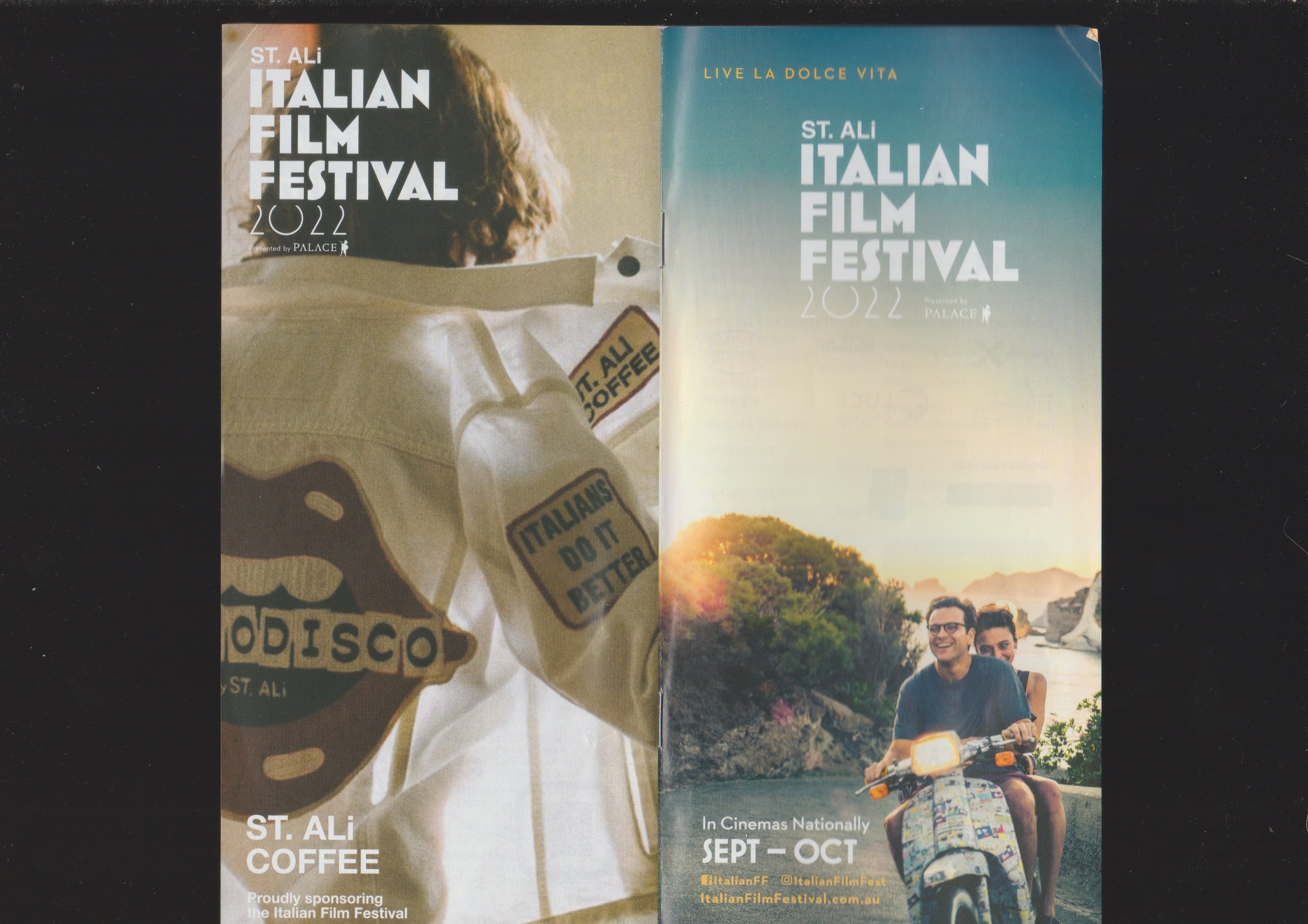Review: Italian Film Festival 2022 — It's about family
The Italian Film Festival returned this year with a bang!
Image Credit: St. ALi Italian Film Festival, Palace Cinemas
The Italian Film Festival returned this year with a bang! Running from 13 September to 26 October, the festival was screened at Palace Cinema venues across Sydney, from Norton Street to Paddington. I was lucky enough to nab tickets, fighting my way through queues of elderly retirees. Nestled in my seat, cheese board and flat white in hand, I turned to see the other five patrons in the cinema, and knew that with such limited turn out, it had to be good.
Andiamo
The films I saw were Mario Martone’s The King of Laughter and Nostalgia, as well as Giuseppe Bonito’s A Girl Returned. Each film subverts the stereotypical tight-knit paradigm of the Italian family, depicting families torn apart, complicated and wrought by infidelity, trauma, incest and economic hardships.
The King of Laughter is set amid the late 18th Century and follows Eduardo Scarpetta, a comedic actor and playwright who is accused of plagiarism after satirising another’s work. Meanwhile, Scarpetta struggles to remain relevant amid the rise of cinema, while keeping his tempestuous family together — an odd collection of people varying in ages who, it turns out, are all either his children or his lovers.
A Girl Returned is about exactly that — a girl returning. Dropped off at her biological parents home, “l’Arminuta”, as her peers call her, struggles to adjust to her new surroundings. Raised in chique 1970s luxury by her aunt and uncle, when arriving at her parents home, the 13 year old girl is confronted by the economic hardships of life, fighting for space in a cramped household of five other siblings, including a crying newborn, and must also deal with an older brother’s inappropriate behaviour and father’s abuse.
Nostalgia follows Felice Lasco, born and raised in the Sanità district of Naples, abroad for nearly 40 years. Returning to care for his dying mother, the local residents wonder why he sticks around after her passing. Through flashbacks, we learn that the gang leader who holds the small community in a vice grip was once Lasco’s friend, but through some tragic event, they parted ways. Now Lasco is here to make amends, and stay in the place he once called home.
Out with the old, in with the new
As suggested, these films depict complex family dynamics, ones that reject the traditional notions of the family unit, for better or for worse. Each film, however, has hopeful and affirmative conclusions which firmly reject the old ways of the world, specifically one’s parentage, and embrace something wholly new and independent.
A Girl Returned sees the protagonist and her younger sister, Adriana, reject both their biological and found parents. The sisters are made to work hard labour on their family farm, fight for space in a claustrophobic household, and avoid the blows of their temperamental parents.
An early scene sees the sisters and their older brother escape for an afternoon to the beach, using money lent to l’Arminuta by her aunt and uncle. While l’Arminuta and Vencenzo are able to jump into the water without fear, Adriana is too frightened of the tide, terrified it might swallow her whole. As the film progresses, l’Arminuta discovers why her aunt and uncle have divorced themselves from her. It is revealed her aunt had an affair with another man and fell pregnant with a child, and was ultimately unwilling to keep both her adoptive daughter and new biological one.
A lavish dining hall plays host to a tense scene between l’Arminuta, Adriana, their aunt and her new wealthy suitor, Guido. The aunt’s child cries in the next room, a complex exchange of looks takes place. Guido is adamant no one sees the child. Adriana, a child of poverty, retrieves the child, used to taking care of her siblings. Guido erupts in a fury, yelling at Adriana to unhand the baby. Calmly, l’Arminuta and Adriana leave, and head towards the beach. In a climax evocative of a baptism, the two sisters go hand in hand into the ocean, rejecting the adults who have cast them aside throughout the film and instead embracing a new life of independence, one defined by sisterhood and love.
In The King of Laughter, the film traces the growing resentment between Scarpetta’s children and their father, stemming from his insistence they follow in his theatrical footsteps as well as his physical and emotional abuse of them. When the film ends, title cards reveal the siblings banded together and ended up making a career for themselves, becoming more famous than Scarpetta ever was.
At the same time, the film has a metatextual theme of evolving form, with the theatre slowly being ushered out as film takes over the public imagination. The film opens with an establishing static black and white shot of horses and carriages moseying about the streets, with weaving amongst the traffic, mimicking the early pre-narrative actuality film. In the film’s climax, as Scarpetta wins his copyright case, the camera slowly pulls back, and the aspect ratio morphs from 16:9 to 4:3. Black bars appear either side of the screen, the colour mutes to black and white, yet the sounds of the courtroom’s cheering and Scarpetta’s revelry can still be heard with a slight reverb. Cinematic development bookends the beginning and end of the film, signalling the transition from early actuality films that merely documented life as it was, to film as a speaking medium with synchronous sound.
Boys and their Bikes
Alongside this, the films also toy with queerness and homosexual love. While no overt homosexual acts occur on screen, they are cleverly coded through looks, gestures, and symbolism — most importantly, the motorbike.
Nostalgia sees Lasco lost in thought as he walks the streets of his old town. The mise-en-scene shifts to grainy 70’s flashbacks shot on 35mm film of an uninhibited youthful Lasco cruising the roads and highways with his best friend, Oreste Spasiano. Gripping each others waists, they ride off into the sunset, and take nude dips in the ocean, stripping themselves and gaining independence of the heteronormative and conservative values of their town.
Lasco is determined to stay in Naples, despite the urges of everyone around him to go home to his wife in Egypt. His wife, who, it should be stated, Lasco seems indifferent towards at best. Their only interaction sees her lazing about on a couch, with his first phone call telling (not asking) her to come live in Naples with him, and the second, an awkward FaceTime call with very little warmth or connection between the pair.
When Lasco finally reunites with Spasiano, he too urges him to leave, and acts like a scorned lover from his past. When Lasco refuses, Spasiano stabs him in an act of both violent, but also erotic penetration.
A Girl Returned is less overt with its queer coding. Vincenzo’s friend is seen only twice — once at the fairground, where his flamboyant style and blazing earing, coupled with the overly affectionate demenour between the men, hinting at any homoerotic tension.Later on, the two men ride their motorcycle together, Vincenzo clutching the waist of the other through glistening pastoral landscapes. Turning a corner on the road, however, they run head first into a bus, with Vincenzo dying.
The two films tether homosexual desire to the motorcycle, reminiscent of the works of Kenneth Anger. In Kustom Kar Kommandos, the delicate wiping down of the various shafts and mechanicals bits of the the engine can be seen as extremely erotic. Long before the days of Michael Bay forcing Meghan Fox to wipe down a bike in Transformers, we had buff men in tight jeans buffering down the reflective surfaces of a car.
At the same time, queerness and the motorcycle have been historically interlinked with queer motorcycle clubs. According to Elizabeth Van Winkle, “LGBTQIA bikers have represented what the straight world historically and still often can’t comprehend: queer men not as dainty stereotypes but as masculine, rugged guys celebrating their sexuality”.
The homosexual tensions and desires between the men in the films, when left unacknowledged, devolve into violence, one in a head on collision and the other in murder.
All the world’s a stage
Liberations from the past, whether they be problematic parentage or heteronormative society, are rooted in locations that hold special power. Each of these films all navigate ideas of space, and the grips they have on individuals.
The King of Laughter pivots between their theatre company and their luscious mansions, with the boundaries separating the two spaces slowly dissolving. The stage is as much their home as their house is, with dramatic family dynamics and revelations taking place in both locations.
The Sanità district of Nostalgia is described as a prison by Spasiano, and Lasco fights against the pressures of everyone telling him to leave. The town holds a corrupting influence over those who inhabit it, the extreme poverty leading people to a life of crime. It is also a space of continual return, with Lasco unable to leave and his mind repeatedly delving back into his memories of another life.
On the other hand, Nostalgia boasts a linguistically diverse script, with characters speaking Italian, Arabic and even French. The film posits that these spaces and their imaginary boundaries hold no power when confronted with the body. Lasco’s body, untethered from the district for 40 years, was able to traverse various continents and countries, adopting multiple languages in the meantime. The body, thus, dissolves the boundaries and prison-like walls of this space, which threatens those inside who intend to keep it as is. However, it is only through his individual autonomy and choice to move freely about the space that allows him to harness this power in a Cartesian act of mind-body synchrony.
A Girl Returned ties the liberation of the young girls to the power of the ocean. The film is about l’Arminuta attempting to find her real home, contrasting the extreme poverty of her biological family and the extreme decadence and chique wealth of her adoptive aunt and uncle. She instead finds a home within the inextricable yet untenable bonds of sisterhood. Emotionally dramatic points of departure are thus linked to the ocean, with the younger sister unwilling to dive into the waters early on in the film, yet is able to at the end, signalling a willingness to be “swallowed whole” by the ocean and gain a sense of independence. This parallels the untethered youth of Lasco and Spasiano in Nostalgia and their baptismal frolic in the sea, both signalling a sense of youth, hope for the future, and unbridled independence that is embodied by these locations.
Arrivederci
The Italian Film Festival was a blast. While I struggled to consume my Palace cheese board in a darkened cinema, the plastic knife unable to penetrate the extremely thick blocks of cheddar cheese prepared for me by a glove wielding Patrick McKenzie of PULP fame, and two of the three films having some pacing issues, I’d do it all again in a heartbeat.
The Italian Film Festival will return in 2023.

